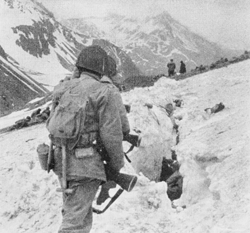 In the predawn hours of May 29, George Gray and his team hiked back into camp, which was now located on the edge of a cliff overlooking Chichagof Valley. They had just patrolled the immediate area and were glad to return. It hadn’t been easy navigating in the dark and, to Gray, the rain felt like marbles pelting his face. But when he looked out over the cliff he saw something he would never forget: “Below us the entire valley, stretching about three miles long, from Chichagof Harbor to Engineer Hill, was criss-crossed in all directions by fiery streaks from trench mortar shells, 37mm cannon projectiles, .50- and .30-caliber machine gun bullets and tracers…, making a weird Dante’s Inferno of the valley,” he recalled.
In the predawn hours of May 29, George Gray and his team hiked back into camp, which was now located on the edge of a cliff overlooking Chichagof Valley. They had just patrolled the immediate area and were glad to return. It hadn’t been easy navigating in the dark and, to Gray, the rain felt like marbles pelting his face. But when he looked out over the cliff he saw something he would never forget: “Below us the entire valley, stretching about three miles long, from Chichagof Harbor to Engineer Hill, was criss-crossed in all directions by fiery streaks from trench mortar shells, 37mm cannon projectiles, .50- and .30-caliber machine gun bullets and tracers…, making a weird Dante’s Inferno of the valley,” he recalled.
Hidden by fog and darkness, and armed with bayonets tied to sticks and any other available weapons, Yamazaki and his 800 men had broken through the American front line. They charged forward into four American camps in the Sarana and Chichagof Valleys. Plunging their bayonets into the sleeping American soldiers, the Japanese screamed, “We die—you die, too!”
It was a full-force banzai attack. Yamazaki’s plan was to raid the American supply of food, weapons, and ammunition on Engineer Hill.
Too far away to help, Gray and his team helplessly witnessed the attack as it raged on for hours, moving farther away from them and closer to Engineer Hill. By mid-afternoon the banzai attack was over. The 500 remaining Japanese soldiers knew that they had been beaten but would never surrender. Pulling the pins of their grenades, striking them on their helmets, and holding them under the chins, they committed one of the biggest mass suicides of World War II. In the end, only 28 Japanese survived to be taken prisoner; more than 2,300 lay dead on the barren island. Of the Americans, 549 were killed in action and 1,148 were wounded. Most of another 2,100 men had suffered severe injuries from the cold.
Japanese troops on Kiska knew they were next. During July, the United States bombed and shelled the island from air and water. On August 15, Verbeck and his group of Cutthroats were the first to go ashore. Their mission was to reconnoiter the area for the 34,000 waiting American and Canadian troops. They found no enemy, gave the go-ahead, and the troops landed without opposition. But as they moved inland, the dense fog returned and, along with it, the sound of explosions and gunfire.
When the fog finally began to clear, there were more than 300 casualties—and a devastating surprise. The troops had been firing their weapons at each other; the Japanese were no longer on Kiska. A cruiser and destroyer force had slipped through the Allied task force and evacuated the entire 5,183-man garrison nearly three weeks before the landing. “There being no Japanese there was the luckiest day of my life, I’ll tell you,” Cutthroat Ed Walker said.
This marked the end of the Aleutian Islands Campaign. The Cutthroats spent the rest of the war in relative safety, scouting and mapping the northern edge of Alaska, field testing military equipment, teaching survival and wilderness skills to other soldiers, and conducting search and rescue operations from their base at Fort Richardson in Anchorage.
In 1944, Colonel Castner received the Distinguished Service Medal for organizing and leading the group that had been so instrumental in wresting the chunk of American soil away from an invading enemy. And he in turn rewarded his team of Cutthroats with high praise for their work, which he called “cool, impartial, correct, and the best.”
Samantha Seiple is a former competitive intelligence specialist and librarian, and is the author of the young adult book Ghosts in the Fog: The Untold Story of Alaska’s WWII Invasion (Scholastic, 2011), which tells the story of the Aleutian Island Campaign. While researching her article on the Alaska Scouts known as Castner’s Cutthroats, she tracked down their last surviving member, Ed Walker, who graciously gave an interview. (Walker died in October 2011 at age 94.) Her website is samanthaseiple.com.




